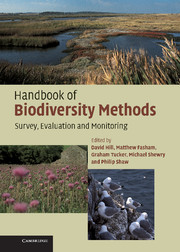Book contents
- Frontmatter
- Contents
- Preface
- Acknowledgements
- Part I Planning
- Part II Habitats
- Part III Species
- 9 Introduction to species assessment
- 10 General principles and methods for species
- 11 Fungi
- 12 Lichens
- 13 Bryophytes
- 14 Aquatic macrophytes and algae
- 15 Vascular plants
- 16 Dragonflies and damselflies
- 17 Butterflies
- 18 Moths
- 19 Other terrestrial invertebrates
- 20 Aquatic invertebrates
- 21 Fish
- 22 Amphibians
- 23 Reptiles
- 24 Birds
- 25 Bats
- 26 Other mammals
- Appendix 1 Monitoring and reporting obligations under international conservation agreements
- Appendix 2 Relationship between BAP Priority Habitat and Broad Habitat categories and Habitats Directive nomenclature
- Appendix 3 Annotated list of key references for plant identification
- Appendix 4 Determining appropriate quadrat size for vegetation sampling
- Appendix 5 The relocation of permanent plots
- Appendix 6 Equipment required for undertaking different types of survey
- Recommended sources of further information
- References
- Glossary
- Index
25 - Bats
Published online by Cambridge University Press: 01 September 2010
- Frontmatter
- Contents
- Preface
- Acknowledgements
- Part I Planning
- Part II Habitats
- Part III Species
- 9 Introduction to species assessment
- 10 General principles and methods for species
- 11 Fungi
- 12 Lichens
- 13 Bryophytes
- 14 Aquatic macrophytes and algae
- 15 Vascular plants
- 16 Dragonflies and damselflies
- 17 Butterflies
- 18 Moths
- 19 Other terrestrial invertebrates
- 20 Aquatic invertebrates
- 21 Fish
- 22 Amphibians
- 23 Reptiles
- 24 Birds
- 25 Bats
- 26 Other mammals
- Appendix 1 Monitoring and reporting obligations under international conservation agreements
- Appendix 2 Relationship between BAP Priority Habitat and Broad Habitat categories and Habitats Directive nomenclature
- Appendix 3 Annotated list of key references for plant identification
- Appendix 4 Determining appropriate quadrat size for vegetation sampling
- Appendix 5 The relocation of permanent plots
- Appendix 6 Equipment required for undertaking different types of survey
- Recommended sources of further information
- References
- Glossary
- Index
Summary
Bats are nocturnal, highly mobile animals that are adapted to foraging for insects in a variety of habitats. Generally during the day they roost in a variety of structures, commonly tree cavities, barns and buildings. In winter, they hibernate in built structures and underground places such as caves and mines.
Most information about bats has been obtained by making emergence counts from roosts, from activity surveys with bat detectors and from monitoring bat boxes, with some records from a variety of other sources. There is scope for gathering good-quality information by the use of novices with minimal training, while skilled enthusiasts, especially helped by modern technology, can produce valid results from a wide spectrum of habitats. The network of bat groups (supported by the Bat Conservation Trust in the UK) provides specialist training of new recruits, although expertise is patchily distributed.
Survey methods (Tables 25.1 and 25.5) include finding roosts by direct observation and locating dispersal routes and feeding habitats, often aided by equipment such as bat detectors (ultrasound detectors), as detailed below:
Day searches: structures (e.g. buildings, walls, bridges, trees, mines and caves), finding signs and/or bats
Dusk observations: emergence counts from roosts, dispersal commuting routes, flight paths from roosts, foraging habitats
Dawn observations: aerial ‘swarming’ at roosts allows location of new roosts
Because of the difficulties inherent in recording bats, and because surveys often produce ‘sample’ rather than absolute results, it is best to encourage keen individuals to undertake projects in which the same methods and dates are used and the same search or time effort is expended, so as to reduce bias.
- Type
- Chapter
- Information
- Handbook of Biodiversity MethodsSurvey, Evaluation and Monitoring, pp. 433 - 449Publisher: Cambridge University PressPrint publication year: 2005

